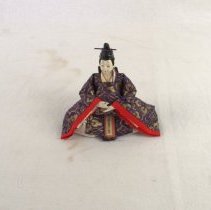Object Record
Images


Metadata
Object Name |
Doll |
Subject |
1930s 1940s Domestic Life Japanese Canadians |
Category |
9: Recreational Artifacts |
Sub-category |
Toy |
Accession Number |
2021.011.001d |
Donor |
Kathy Nazaroff (nee Hollas/Kraemer) |
Description |
Japanese Hina Doll in wooden crate (a-b). Emperor with painted black hair, wearing a purple and gold robe with red cuffs |
Dimensions |
H-10.5 W-13 cm |
Provenance |
-Donated on behalf of the donors mother Lidia Hollas (nee Kraemer) -Still in origional wood -Kraemers maternity ward- family connection -Hollas + Dubie families, Family came from historic home in mission now subdivided Wooden box with dolls, 2 screens black and green platforms with red cushions -These dolls were given to Lidia Hollas (nee Kraemer) by a Japanese school mate who came to her home and gave them to her for safe keeping during the mandatory evacuation. Lidia recounts that this family never returned to Mission, as a result she has held onto these dolls all this time. Here is an exclusive look at the newest addition to our doll collection! Donated in their original wood box, these traditional Hina dolls were used as a means of celebrating Hinamatsuri, or the doll festival, one of five sekku, or seasonal festivals, celebrated throughout the year in Japan. During the holiday, also known as momo no sekku or the peach festival, families display ceramic dolls dressed in the decorative robes of the ancient imperial court. The manufacturing of these figurines is still an example of traditional Japanese craftwork. By focusing on marriage and families, Hinamatsuri represented Japanese hopes and values, and as the dolls were said to represent the emperor and empress, it also fostered respect for the throne. These are traditionally displayed on a red-carpeted, stepped platform called a hinadan, where you can see the central figurines of the festival, the male odairisama and female ohinasama, representing members of the imperial family, members of the court, musicians and other attendants. Whether an odairisama or an attendant, each doll is intricately decorated. During the Edo period, between 1603 and 1867, it became custom to offer these dolls to little girls of all classes. This festival is still celebrated today! Leading up to WWII many Japanese farmers came to Mission, drawn in by the relatively cheap land. By working the hillsides, land that was considered to be unproductive and hard to work, the hardworking farmers greatly contributed to Mission's berry growing capacity. After the bombing of Pearl Harbour, Canada declared war on Japan. In April of 1942, the forced evacuation of Mission's Japanese-Canadians began, and over several weeks, nearly 600 people were unwillingly sent away. These dolls were given to Lydia Hollas (nee Kraemer) by a Japanese school mate for safe keeping during the mandatory evacuation. Lydia recounts that this family never returned to Mission, as a result she has held onto these dolls all this time. |
Accession number |
2021.011 |
